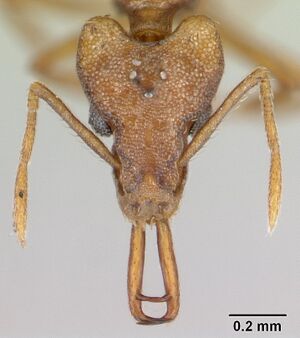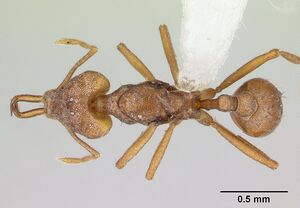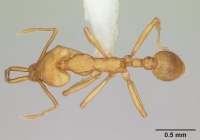Strumigenys szalayi
| Strumigenys szalayi | |
|---|---|

| |
| Scientific classification | |
| Kingdom: | Animalia |
| Phylum: | Arthropoda |
| Class: | Insecta |
| Order: | Hymenoptera |
| Family: | Formicidae |
| Subfamily: | Myrmicinae |
| Tribe: | Attini |
| Genus: | Strumigenys |
| Species: | S. szalayi |
| Binomial name | |
| Strumigenys szalayi Emery, 1897 | |
| Synonyms | |
| |
Known from litter collections, rotten wood on the ground and a single collection taken from under a rock. Occurs in a range of forest habitats, from swamp forest through to higher altitude montane forest.
Identification
Bolton (2000) - A member of the Strumigenys szalayi-group. Brown (1971) considered the morphological and geographical variation of the widespread szalayi in some detail. He discussed the large size-variation recorded but retained all the samples in one species. Since then Roy Snelling (LACM) has collected a series at Wapoga camp, Irian Jaya, whose darkly coloured workers are even larger than the biggest specimen recorded by Brown. These workers have HL ca 1.00 but morphologically seem inseparable from other samples currently included in szalayi. I have retained this series in szalayi but with some misgivings. I suspect that a detailed re-analysis, when more of these anomalous specimens are available, may change our concept of the species.
S. szalayi is only separated from Strumigenys hemichlaena by differences in colour; see there and note under Strumigenys tigris.
Keys including this Species
Distribution
Latitudinal Distribution Pattern
Latitudinal Range: 7.52011° to -19.01134381°.
| North Temperate |
North Subtropical |
Tropical | South Subtropical |
South Temperate |
- Source: AntMaps
Distribution based on Regional Taxon Lists
Australasian Region: Australia (type locality).
Indo-Australian Region: Indonesia, Micronesia (Federated States of), New Guinea, Philippines, Samoa, Singapore, Solomon Islands, Vanuatu.
Distribution based on AntMaps
Distribution based on AntWeb specimens
Check data from AntWeb
Countries Occupied
| Number of countries occupied by this species based on AntWiki Regional Taxon Lists. In general, fewer countries occupied indicates a narrower range, while more countries indicates a more widespread species. |

|
Estimated Abundance
| Relative abundance based on number of AntMaps records per species (this species within the purple bar). Fewer records (to the left) indicates a less abundant/encountered species while more records (to the right) indicates more abundant/encountered species. |

|
Biology
Brown (1971) - A colony I collected at Kuranda. Queensland consisted of about 60 workers and 2 dealate females nesting beneath a sheet of fungus on the underside of a piece: of bark lying on the floor of rain forest. The colony was transferred to a small glass-topped plaster nest and was offered various small, living soft-bodied arthropods during a 3-day observation on the ants' food preferences. Although offered small nematocerous Diptera, aphids, various mites, minute spiders and an assortment of springtails, the S. szalayi took only entomobryoid Collembola during this period. I had no opportunity to observe the ants under circumstances of prolonged food scarcity, so I do not know whether such conditions would lead to acceptance of other prey organisms, but it is reasonably clear the S. szalayi is predominantly a collembolan predator. The preferred prey were members of subfamily Paronellinae, common in the rain forests of northern Queensland; poduroids were avoided. Hunting by S. szalayi is relatively active and efficient; in striking, the mandibles are opened to more than 180°.
Castes
Queen
Images from AntWeb
   
| |
| Queen (alate/dealate). Specimen code casent0178463. Photographer April Nobile, uploaded by California Academy of Sciences. | Owned by BNM, Koror, Palau. |
Nomenclature
The following information is derived from Barry Bolton's Online Catalogue of the Ants of the World.
- szalayi. Strumigenys szalayi Emery, 1897c: 578, pl. 14, figs. 10, 11 (w.q.) NEW GUINEA. Senior synonym of australis: Brown, 1971c: 75. See also: Bolton, 2000: 906.
- australis. Strumigenys szalayi subsp. australis Forel, 1910b: 50 (w.m.) AUSTRALIA. Wheeler, G.C. & Wheeler, J. 1955a: 137 (l.). Junior synonym of szalayi: Brown, 1971c: 75.
Unless otherwise noted the text for the remainder of this section is reported from the publication that includes the original description.
Description
Worker
Bolton (2000) - TL 2.4-3.5, HL 0.68-0.94, HW 0.48-0.62, CI 64-75, ML 0.34-0.52, MI 50-57, SL 0.40-0.66, SI 88-106, PW 0.26-0.34, AL 0.68-0.91 (32 measured).
With head in profile the postocular concavity in the vetrolateral margin broad and quite shallow, but distinct. Propodeal teeth not long and spiniform, length very obviously less than twice the distance separating their bases. Alitrunk reticulate-punctate, often with a small un sculptured patch on katepisternum. Hairs on first gastral tergite similar to those on postpetiole. Colour variable (Brown, 1971), uniformly yellow to uniformly brown, or with gaster slightly to very much darker in shade than head and alitrunk, but head and alitrunk never bicoloured black and yellow.
Queen
Brown (1971) - The female is much like the worker, with the usual caste differences, slightly larger size, etc.
Male
Brown (1971) - 1 specimen taken with workers, Negros I., Philippines, 18-V-22: TL 2.4, HL 0.52, WL 0.78, greatest diameter of eve 0.16, forewing L about 1.7 mm.
Occipital depression moderate. Scutellum and metanotum both projecting, the latter medially angulate. Propodeal teeth well-developed, acute. Petiole and postpetiole without appendages, their surfaces densely reticulate-punctate. Color ferruginous brown, legs and appendages dull yellow.
Type Material
Brown (1971) - Worker, female, worker pupae. Type loc.: Seleo Island, near Berlinhafen (=Aitape). New Guinea, by present selection. Other original locs.: Beliao Island, near Friedrich Wilhelmsafen (=Madang), New Guinea. Syntypes in Hungarian Natural History Museum, National Museum of Natural History, etc., several seen.
Bolton (2000) - Syntype workers and queen, PAPUA NEW GUINEA: Madang (= Friedrich-Wilhelmshafen) (L. Biro) (Hungarian Natural History Museum, Museo Civico di Storia Naturale, Genoa) [examined].
- Syntype, worker(s), male(s), Kuranda near Cairns, Queensland, Australia, The Natural History Museum.
- Syntype, worker(s), male(s), Kuranda near Cairns, Queensland, Australia, Musee National d'Histoire Naturelle.
- Syntype, Seleo Island near Aitape (as Berlinhafen), Papua New Guinea, museum unknown (prob. MCSN (Genoa) or HNHM (Budapest)).
References
- Bolton, B. 2000. The ant tribe Dacetini. Memoirs of the American Entomological Institute. 65:1-1028. (page 906, fig. 479 redescription of worker)
- Brown, W. L., Jr. 1971c. The Indo-Australian species of the ant genus Strumigenys: group of szalayi (Hymenoptera: Formicidae). Pp. 73-86 in: Asahina, S., et al. (eds.) Entomological essays to commemorate the retirement of Professor K. Yasumatsu. Tokyo: Hokuryukan Publishing Co. (page 75, senior synonym of australis, redescription of worker)
- Emery, C. 1897c. Formicidarum species novae vel minus cognitae in collectione Musaei Nationalis Hungarici quas in Nova-Guinea, colonia germanica, collegit L. Biró. Természetr. Füz. 20: 571-599. (page 578, pl. 14, figs. 10, 11 worker, queen described)
- Emery, C. 1924f [1922]. Hymenoptera. Fam. Formicidae. Subfam. Myrmicinae. [concl.]. Genera Insectorum 174C: 207-397 (page 322, catalogue)
- Taylor, R. W.; Brown, D. R. 1985. Formicoidea. Zool. Cat. Aust. 2:1- 149: 1-149, 30 (page 88, catalogue)
- Wang, W.Y., Soh, E.J.Y., Yong, G.W.J., Wong, M.K.L., Benoit Guénard, Economo, E.P., Yamane, S. 2022. Remarkable diversity in a little red dot: a comprehensive checklist of known ant species in Singapore (Hymenoptera: Formicidae) with notes on ecology and taxonomy. Asian Myrmecology 15: e015006 (doi:10.20362/am.015006).
- Wheeler, G. C.; Wheeler, J. 1955a [1954]. The ant larvae of the myrmicine tribes Basicerotini and Dacetini. Psyche (Camb.) 61: 111-145 (page 137, larva described)
- Wilson, E. O.; Taylor, R. W. 1967b. The ants of Polynesia (Hymenoptera: Formicidae). Pac. Insects Monogr. 14: 1-109 (page 41, redescription of worker)
References based on Global Ant Biodiversity Informatics
- Bolton, B. 2000. The Ant Tribe Dacetini. Memoirs of the American Entomological Institute 65
- Brown W. L., Jr. 1971. The Indo-Australian species of the ant genus Strumigenys: group of szalayi (Hymenoptera: Formicidae). Pp. 73-86 in: Asahina, S., et al. (eds.) Entomological essays to commemorate the retirement of Professor K. Yasumatsu. Tokyo: Hokuryukan Publishing Co., vi + 389 pp.
- CSIRO Collection
- Chapman, J. W., and Capco, S. R. 1951. Check list of the ants (Hymenoptera: Formicidae) of Asia. Monogr. Inst. Sci. Technol. Manila 1: 1-327
- Clouse R. M. 2007. The ants of Micronesia (Hymenoptera: Formicidae). Micronesica. 39: 171-295.
- Clouse, R.M. 2007. The ants of Micronesia (Hymenoptera: Formicidae), Micronesica 39(2): 171-295.
- Dlussky G.M. 1994. Zoogeography of southwestern Oceania. Zhivotnoe naselenie ostrovov Iugo-Zapadnoi Okeanii ekologo-geograficheskie issledovanii 48-93.
- Emery C. 1897. Formicidarum species novae vel minus cognitae in collectione Musaei Nationalis Hungarici quas in Nova-Guinea, colonia germanica, collegit L. Biró. Természetrajzi Füzetek 20: 571-599.
- Field Museum Collection, Chicago, Illinois (C. Moreau)
- Janda M., G. D. Alpert, M. L. Borowiec, E. P. Economo, P. Klimes, E. Sarnat, and S. O. Shattuck. 2011. Cheklist of ants described and recorded from New Guinea and associated islands. Available on http://www.newguineants.org/. Accessed on 24th Feb. 2011.
- Kami K.S., and S. E. Miller. 1998. Samoan insects and related arthropods: checklist and bibliography. Bishop Museum Technical Report 13, pp 121.
- Kami KS & Miller SE. 1998. Samoan insects and related arthropods: checklist and bibliography. Bishop Museum Technical Report No. 13.
- Lucky A., E. Sarnat, and L. Alonso. 2011. Ants of the Muller Range, Papua New Guinea, Chapter 10. In Richards, S. J. and Gamui, B. G. (editors). 2013. Rapid Biological Assessments of the Nakanai Mountains and the upper Strickland Basin: surveying the biodiversity of Papua New Guineas sublime karst environments. RAP Bulletin of Biological Assessment 60. Conservation International. Arlington, VA.
- Room P. M. 1975. Diversity and organization of the ground foraging ant faunas of forest, grassland and tree crops in Papua Nez Guinea. Aust. J. Zool. 23: 71-89.
- Room, P.M. 1975. Relative Distributions of Ant Species in Cocoa Plantations in Papua New Guinea Relative Distributions of Ant Species in Cocoa Plantations in Papua New Guinea. Journal of Applied Ecology 12(1):47-61
- Sagata, K., A.L. Mack, D.D. Wright and P.J. Lester. 2010. The influence of nest avaiability on the abundance and diversity of twig-dwelling ants in a Papua New Guinea forest. Insectes Sociaux 57:333-341
- Snelling R. R. 1998. Insect Part 1: The social Hymenoptera. In Mack A. L. (Ed.) A Biological Assessment of the Lakekamu Basin, Papua New Guinea, RAP 9. 189 ppages
- Snelling R. R. 2000. Ants of the Wapoga river area, Irian Jaya, Indonesia. In Mack, Andrew L. and Leeanne E. Alonso (eds.). 2000. A Biological Assessment of the Wapoga River Area of Northwestern Irian Jaya, Indonesia. RAP Bulletin of Biological Assessment 14, Conservation International, Washington, DC.
- Taylor R. W. 1987. A checklist of the ants of Australia, New Caledonia and New Zealand (Hymenoptera: Formicidae). CSIRO (Commonwealth Scientific and Industrial Research Organization) Division of Entomology Report 41: 1-92.
- Viehmeyer H. 1912. Ameisen aus Deutsch Neuguinea gesammelt von Dr. O. Schlaginhaufen. Nebst einem Verzeichnisse der papuanischen Arten. Abhandlungen und Berichte des Königlichen Zoologischen und Anthropologische-Ethnographischen Museums zu Dresden 14: 1-26.
- Wetterer, James K. and Vargo, Donald Vargo L. 2003. Ants (Hymenoptera: Formicidae) of Samoa. Pacific Science. 57(4):409-419.
- Wilson E. O.; Taylor, R. W. 1967. The ants of Polynesia (Hymenoptera: Formicidae). Pacific Insects Monograph 14:1-109.
- Wilson E.O., and G.L. Hunt. 1967. Ant fauna of Futuna and Wallis islands, stepping stones to Polynesia. Pacific Insects 9(4): 563-584.
- Wilson EO, Hunt GL. 1967. Ant fauna of Futuna and Wallis Islands, stepping stones to Polynesia. Pacific Insects 9.4: 563-584.
- Wilson EO, Taylor RW. 1967. The ants of Polynesia. Pacific Insects Monograph 14:1-109.
- Wilson, Edward O. and George L. Hunt. 1967. Ant Fauna of Futuna and Wallis Islands, Stepping Stones To Polynesia. Pacific Insects. 9(4):563-584.
- Wilson, Edward O. and Hunt, George L. Jr. 1967. Ant Fauna of Futuna and Wallis Islands, Stepping Stones to Polynesia. Pacific Insects. 9(4):563-584

